Garden Maintenance in Southgate
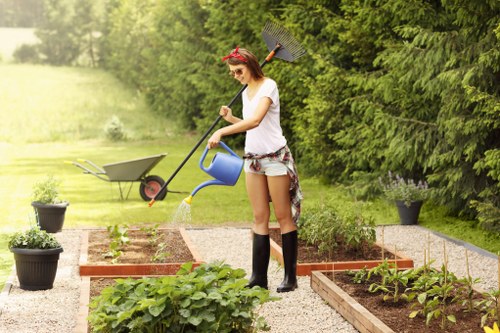
Maintaining a beautiful garden in Southgate requires dedication, knowledge, and the right tools. Whether you're a seasoned gardener or a beginner, understanding the specific needs of your garden can make all the difference. Southgate's unique climate and soil conditions offer both challenges and opportunities for creating a thriving outdoor space.
Regular garden maintenance not only enhances the aesthetic appeal of your property but also promotes the health and growth of your plants. From lawn care to pruning shrubs, each task plays a crucial role in maintaining a vibrant and sustainable garden.
In this guide, we'll explore the essential aspects of garden maintenance in Southgate, providing you with practical tips and strategies to keep your garden looking its best all year round.
Understanding Southgate's Climate
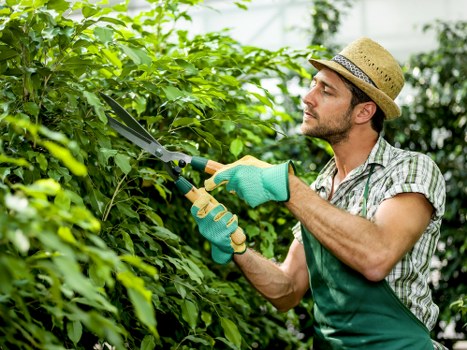
Southgate experiences a temperate climate with mild winters and warm summers, making it suitable for a wide variety of plants. However, it's essential to consider local weather patterns when planning your garden maintenance schedule.
Rainfall in Southgate is fairly evenly distributed throughout the year, but summers can bring occasional droughts. This variability means that irrigation systems and water conservation techniques are vital for maintaining healthy gardens.
By understanding the climatic conditions, you can select plants that are well-suited to the environment, reducing the need for excessive watering and ensuring better growth and resilience against pests and diseases.
Seasonal Garden Maintenance Tasks
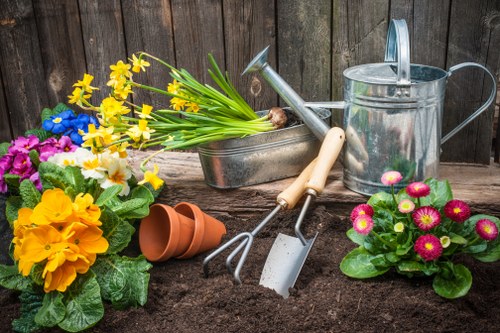
Different seasons bring different challenges and opportunities for garden maintenance. Here's a breakdown of essential tasks for each season in Southgate:
Spring
Spring is the time to prepare your garden for the growing season. Start by clearing out any debris and dead plants from the winter months. Pruning shrubs and trees encourages healthy new growth, and planting early-blooming flowers can add vibrant colors to your garden.
Summer
During the summer, focus on regular watering, especially during dry spells. Mulching helps retain soil moisture and suppresses weeds. Deadheading spent flowers promotes continued blooming, and pest control measures are essential to protect your plants from common summer pests.
Autumn
Autumn is ideal for planting perennials and preparing your garden for the colder months. Raking fallen leaves prevents them from suffocating your plants, and applying compost enriches the soil for next year’s growth.
Winter
In winter, focus on protecting sensitive plants from frost and snow. Covering beds with mulch or protective fabrics can help insulate the soil. It's also a good time to plan your garden layout and order seeds for the upcoming spring.
Lawn Care in Southgate
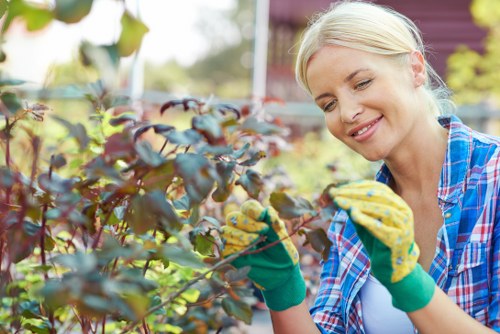
A lush, green lawn is a cornerstone of any well-maintained garden in Southgate. Proper lawn care involves several key practices:
- Mowing: Regular mowing at the correct height encourages healthy grass growth and prevents weeds.
- Watering: Deep, infrequent watering promotes strong root systems. Early morning is the best time to water to reduce evaporation.
- Fertilizing: Applying the right type of fertilizer provides essential nutrients to your grass, enhancing its color and resilience.
- Weed Control: Removing weeds promptly prevents them from taking over and competing with your grass for resources.
By following these lawn care practices, you can maintain a vibrant and resilient lawn that enhances the overall appeal of your Southgate garden.
Plant Selection and Care

Choosing the right plants is crucial for successful garden maintenance in Southgate. Consider native plants that are well-adapted to the local climate and soil conditions. These plants typically require less water and are more resistant to local pests and diseases.
When selecting plants, think about their growth habits, light requirements, and water needs. Grouping plants with similar requirements together can simplify maintenance and ensure that each plant thrives in its designated spot.
Regular care, including watering, fertilizing, pruning, and pest management, is essential to keep your plants healthy and attractive. Pay attention to specific needs of each plant type and adjust your maintenance routine accordingly.
Soil Health and Fertilization

Healthy soil is the foundation of a thriving garden. In Southgate, preparing your soil involves:
- Testing Soil pH: Understanding the pH level helps in selecting the right plants and amending the soil as needed.
- Adding Organic Matter: Compost and well-rotted manure improve soil structure, fertility, and water retention.
- Mulching: Applying mulch conserves moisture, regulates soil temperature, and suppresses weeds.
- Fertilizing: Use appropriate fertilizers to supply essential nutrients based on soil test results.
Maintaining soil health ensures that your plants have the necessary nutrients and support to grow vigorously and resist diseases.
Pruning and Trimming
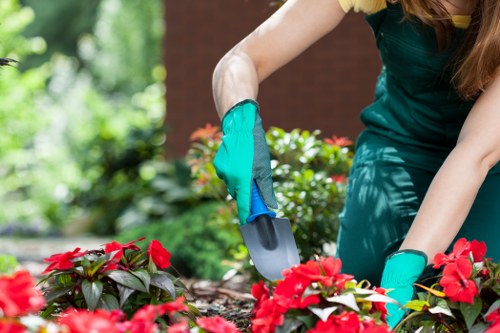
Regular pruning and trimming are essential for maintaining the shape, size, and health of your plants. Proper pruning encourages better airflow, sunlight penetration, and removes dead or diseased branches that could harm the plant.
Different plants require different pruning techniques and timing. For instance, flowering shrubs may need to be pruned after blooming, while fruit trees benefit from pruning during their dormant season.
Investing time in proper pruning practices can significantly enhance the appearance and longevity of your garden plants.
Pest and Disease Management

Protecting your garden from pests and diseases is a critical aspect of maintenance. Integrated Pest Management (IPM) strategies can help control pests while minimizing environmental impact:
- Monitoring: Regularly inspect plants for signs of pests or diseases to catch issues early.
- Biological Controls: Encourage beneficial insects like ladybugs and predatory beetles that naturally control pest populations.
- Cultural Practices: Proper spacing, watering, and sanitation can reduce the likelihood of pest infestations and disease outbreaks.
- Chemical Controls: Use pesticides as a last resort, choosing environmentally friendly options when necessary.
Maintaining a balanced ecosystem in your garden helps prevent pests and diseases from becoming severe problems.
Irrigation and Water Management
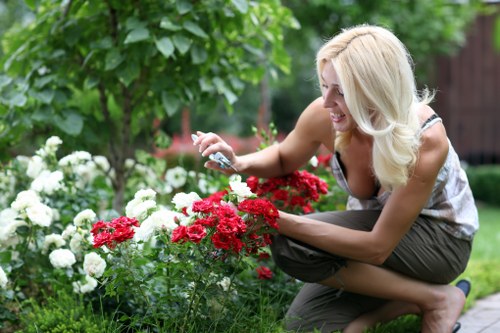
Effective irrigation is crucial for garden maintenance in Southgate, especially during the dry summer months. Here are some best practices:
- Drip Irrigation: Delivers water directly to the plant roots, reducing evaporation and water waste.
- Rainwater Harvesting: Collecting and storing rainwater can provide a sustainable water source for your garden.
- Soaker Hoses: Efficiently water plant beds without wetting foliage, reducing the risk of fungal diseases.
- Watering Schedule: Water early in the morning to minimize evaporation and ensure plants have ample moisture throughout the day.
Implementing smart watering techniques conserves water and keeps your garden healthy and thriving.
Mulching Techniques

Mulching is an effective garden maintenance practice that offers multiple benefits:
- Moisture Retention: Keeps the soil consistently moist, reducing the need for frequent watering.
- Weed Suppression: Prevents weeds from germinating and competing with your plants for nutrients.
- Temperature Regulation: Insulates the soil, protecting plant roots from extreme temperatures.
- Soil Improvement: Organic mulches decompose over time, enriching the soil with valuable nutrients.
Choosing the right type of mulch, such as organic materials like bark, straw, or compost, can enhance these benefits and contribute to a healthier garden ecosystem.
Composting and Soil Enrichment
Composting is a sustainable practice that turns organic waste into valuable soil amendments. By composting kitchen scraps, garden waste, and other biodegradable materials, you create nutrient-rich compost that improves soil structure and fertility.
Adding compost to your garden enhances microbial activity, which is essential for breaking down organic matter and making nutrients available to plants. Regular compost application can lead to healthier plants and increased garden productivity.
Setting up a compost bin in Southgate allows you to manage waste efficiently while contributing to a more sustainable gardening practice.
Hardscaping and Garden Structures
Incorporating hardscaping elements such as paths, patios, and pergolas adds functionality and aesthetic appeal to your garden. Proper maintenance of these structures ensures their longevity and enhances the overall look of your outdoor space.
Regular cleaning, sealing, and repairs prevent wear and tear from weather exposure. Designing pathways with durable materials like stone or gravel can reduce weed growth and improve accessibility.
Garden structures also provide focal points and can create defined areas for different activities, contributing to a well-organized and inviting garden layout.
Lighting and Electrical Maintenance
Outdoor lighting enhances the beauty and functionality of your garden after dark. Proper maintenance of lighting systems ensures safety and prolongs the lifespan of your fixtures.
Check for any electrical issues, replace burnt-out bulbs, and clean lighting fixtures regularly to maintain their brightness and appearance. Solar-powered lights are an eco-friendly option that reduces energy consumption and installation costs.
Strategically placed lighting can highlight garden features, create ambiance, and provide security, making it a valuable addition to your garden maintenance plan.
Choosing Professional Garden Maintenance Services
While DIY garden maintenance can be rewarding, hiring professional services in Southgate offers several advantages:
- Expertise: Trained professionals understand local conditions and can provide tailored maintenance solutions.
- Time-Saving: Outsourcing garden tasks allows you to enjoy your outdoor space without the hassle of upkeep.
- Comprehensive Services: Professional gardeners offer a wide range of services, from landscaping and planting to pest control and irrigation management.
- Quality Results: Experienced gardeners ensure that maintenance tasks are performed efficiently and to high standards.
Consider hiring a reputable garden maintenance service in Southgate to achieve a well-maintained and beautiful garden with less effort.
Sustainable Gardening Practices
Sustainability is increasingly important in garden maintenance. Implementing eco-friendly practices not only benefits the environment but also enhances the health of your garden:
- Water Conservation: Use efficient irrigation systems and drought-resistant plants to minimize water usage.
- Organic Gardening: Avoid synthetic chemicals by using natural fertilizers and pest control methods.
- Native Plant Selection: Choose native species that require less maintenance and are more resilient to local conditions.
- Recycling and Upcycling: Repurpose materials for garden structures and reduce waste by composting organic matter.
Adopting sustainable gardening practices ensures a healthy, resilient garden while contributing to environmental conservation.
Enhancing Garden Biodiversity
Biodiversity in your garden supports a balanced ecosystem, attracting beneficial insects, birds, and other wildlife. Here's how to enhance biodiversity:
- Plant Diversity: Incorporate a variety of plants, including flowering species, shrubs, and trees, to provide different habitats and food sources.
- Pollinator Gardens: Grow plants that attract bees, butterflies, and other pollinators to promote plant reproduction and ecosystem health.
- Wildlife Habitats: Create habitats like birdhouses, water features, and insect hotels to encourage wildlife presence.
- Native Plants: Support local biodiversity by planting species that are native to Southgate, which provide essential resources for native wildlife.
A biodiverse garden is not only visually appealing but also more resilient against pests and diseases, ensuring long-term sustainability.
Garden Tools and Equipment
Having the right tools and equipment is essential for efficient garden maintenance. Invest in high-quality tools that are comfortable and durable:
- Basic Tools: Essential tools include a spade, rake, pruning shears, and watering equipment.
- Power Tools: Consider using a lawnmower, hedge trimmer, and tiller for larger garden areas.
- Safety Gear: Protect yourself with gloves, goggles, and sturdy footwear while working in the garden.
- Storage: Keep your tools organized and protected from the elements with a dedicated storage shed or toolbox.
Regular maintenance of your garden tools extends their lifespan and ensures that they perform effectively when needed.
Creating a Maintenance Schedule
Developing a garden maintenance schedule helps you stay organized and ensures that all tasks are completed timely. Here's how to create an effective schedule:
- Assess Your Garden: Identify all areas that need maintenance, including lawns, flower beds, shrubs, and trees.
- Prioritize Tasks: Determine which tasks are urgent and which can be scheduled for later.
- Set Realistic Goals: Break down large tasks into manageable steps and assign them to specific days or weeks.
- Use a Calendar: Mark important dates for planting, pruning, fertilizing, and other maintenance activities on a calendar.
- Adjust as Needed: Be flexible and adjust your schedule based on weather conditions and the growth patterns of your plants.
A well-planned maintenance schedule ensures that your garden remains healthy and beautiful throughout the year.
Troubleshooting Common Garden Issues
Even with regular maintenance, gardens can face various issues. Being prepared to troubleshoot common problems is essential:
Pest Infestations
Identify the type of pest and determine the best control method. Use organic solutions whenever possible to minimize harm to beneficial insects.
Disease Outbreaks
Recognize symptoms early and remove affected plants to prevent the spread of disease. Improve air circulation and avoid overhead watering to reduce fungal issues.
Weed Overgrowth
Consistent weeding prevents weeds from establishing. Use mulch to suppress weed growth and consider using landscape fabric for added control.
Soil Degradation
Regularly amend your soil with compost and organic matter to maintain fertility and structure. Avoid over-fertilizing, which can lead to nutrient imbalances.
Innovative Garden Technologies
Embracing modern technologies can streamline garden maintenance and enhance efficiency:
- Smart Irrigation Systems: Automated watering systems that adjust based on weather conditions and soil moisture levels.
- Garden Management Apps: Mobile applications that help schedule tasks, track plant growth, and manage garden activities.
- LED Grow Lights: Energy-efficient lighting solutions for indoor or greenhouse gardening.
- Robotic Mowers: Autonomous lawnmowers that maintain your lawn with minimal effort.
Integrating these technologies can reduce manual labor, conserve resources, and ensure consistent garden maintenance.
Enhancing Curb Appeal with Garden Maintenance
A well-maintained garden significantly boosts the curb appeal of your Southgate home. First impressions matter, and a lush, vibrant garden can increase property value and create a welcoming atmosphere.
Focus on key areas such as front lawns, entryways, and visible garden beds. Consistent maintenance, including trimming, planting seasonal flowers, and keeping pathways clear, ensures your garden always looks its best.
Incorporate decorative elements like sculptures, garden furniture, and lighting to add personality and charm, making your garden an inviting space for both you and your guests.
Eco-Friendly Garden Maintenance Tips
Adopting eco-friendly practices in garden maintenance benefits the environment and promotes sustainability:
- Reduce Chemical Use: Opt for natural fertilizers and pest control methods to minimize chemical runoff and protect wildlife.
- Conserve Water: Implement rainwater harvesting and efficient irrigation systems to reduce water consumption.
- Compost: Turn organic waste into valuable compost, reducing landfill waste and enriching your soil.
- Plant Diversity: Support biodiversity by growing a variety of plants that provide habitats for different species.
Eco-friendly garden maintenance not only preserves natural resources but also creates a healthier and more resilient garden ecosystem.
Final Thoughts on Garden Maintenance in Southgate
Maintaining a garden in Southgate is a rewarding endeavor that enhances the beauty and value of your property while providing a peaceful retreat. By understanding the local climate, selecting appropriate plants, and implementing regular maintenance practices, you can create a thriving garden that stands the test of time.
Whether you choose to maintain your garden yourself or hire professional services, consistency and attention to detail are key to achieving the best results. Embrace sustainable practices, stay informed about gardening trends, and enjoy the process of nurturing your outdoor space.
Ready to transform your garden? Contact us today to explore professional garden maintenance services tailored to your needs in Southgate. Let us help you create and maintain the garden of your dreams.

